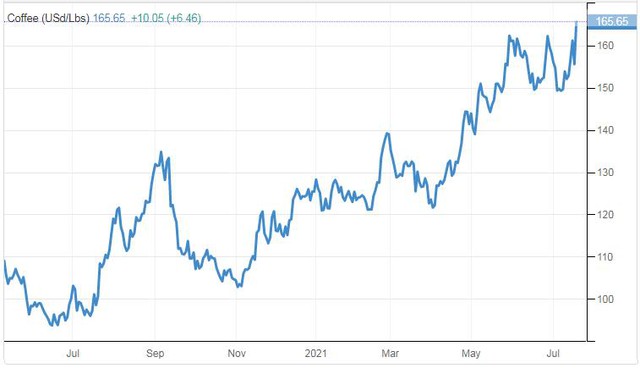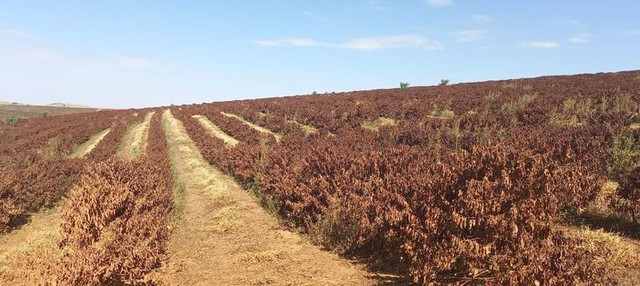In the session of July 20 alone, the price of arabica coffee increased by more than 6% due to increasing concerns about damage caused by consecutive frosts in Brazil.
Ending this session, arabica coffee for September futures rose 10.4 cents, or 6.6%, to $1,668/lb, close to the highest level in 4.5 years; During the session, there was a time when the price increased by 7.7%. In the past 2 months, the price of arabica has increased by 37%, and compared to the beginning of 2021, the price has increased by about 30%.

Robusta coffee delivered in September at the end of the session on July 20 also increased by 29 USD, or 1.7%, to 1,761 USD/ton, after reaching a 3-year high at 1,793 USD/ton in the same session. . Robusta has also increased in price by about 30% in the past three months.
On the domestic market, coffee prices on July 21 also reversed to increase strongly again. Accordingly, the purchase price in key growing areas increased by an average of 400-500 VND/kg compared to yesterday morning.
In Di Linh, Lam Ha, Bao Loc (Lam Dong) districts, coffee was purchased today for 35,300 VND/kg; in Cu M’gar district (Dak Lak), the purchase price is 36,200 VND/kg; while in Ea H’leo district (Dak Lak), Buon Ho (Dak Lak), the purchase price is 36,100 VND/kg.
Similarly in Dak Nong province, the price of coffee purchased today is 36,100 VND/kg in Gia Nghia and 36,000 VND/kg in Dak R’lap. In Gia Lai province, the price of coffee today is at 36,100 VND/kg (Chu Prong), in Pleiku and La Grai the same price at 36,000 VND/kg. The price of coffee today in Kon Tum province is purchased at 36,100 VND/kg.
Frost has returned to Brazil’s key coffee growing regions for the second time in less than a month, severely affecting coffee crops in the country’s key producing states, such as Minas Gerais and Sao Paulo.
Coffee plants are very sensitive to frost because they kill their leaves and can have consequences that last into the next crop.
“The market is currently trying to gauge the extent of frost damage. This is the first time we’ve seen widespread frost coverage in (Brazil’s) key coffee belt,” said analyst Carlos Mera. of Rabobank said.
“Some regions were hit much harder than I thought,” said soft commodities analyst Paul Daly, of the US.
The world’s largest coffee exporter – Brazil – is facing its coldest frosts in more than 25 years, worsening the outlook for coffee production and threatening to push the This popular drink in the world skyrockets in the near future.
Temperatures in Brazil’s coffee-growing regions dipped below 00C (32 degrees Fahrenheit) for hours on Tuesday night (July 20), with southern Minas Gerais being the coldest since 1994. Frost is forecast to continue in the southernmost part of the country during the day and night of July 21, and another cold wave is expected on July 29.
It is worth mentioning that before this frost, Brazil experienced a severe drought, which made the fields of copper arid, irrigation reservoirs depleted. The drought is not over yet, which is forecast to get worse due to the possibility of a reappearance of the La Nina weather phenomenon, which drastically reduces rainfall in the region.
Francisco Cesar Di Giacomo, a farmer in Sao Goncalo do Sapucai in Minas Gerais, said the frost affected about 60 percent of his crop. “In some areas of the farm, the coffee trees have died,” said Di Giacomo.
Frost could scorch leaves and branches on trees, dampening production prospects for 2022 and dashing hopes of the best bumper crop in decades to replenish stockpiles. This is especially important because coffee trees have a high yield once every two years, and the next crop should be a high yield cycle.

Brazil coffee stocks plummeted giảm
According to Regis Ricco, director of RR Consultoria Rural, many fields were pruned last year in anticipation of the 2022 crop, but what is happening now shows that yields are very likely to fall, even in next year. The past two frosts threaten to reduce Brazil’s coffee production by 1 million to 2 million bags in the 2022-23 crop year, according to a survey conducted by Cazarini Trading, based in Minas Gerais.
A drought earlier this year reduced production of arabicas, the coffee favored by Starbucks Corp. In the northern regions of Sao Paulo and Triangulo Mineiro in Minas, soil moisture is currently around 20%, below the 60% needed for crop growth.
Drought makes coffee beans smaller, even hollow. Therefore, each bag of coffee this season needs to be filled with 600 liters (158.5 gallons) to be 60 kg, while normally only 450 – 500 liters are needed.
Daniel Daianas Ribeiro, a 42-year-old farmer with a family-run coffee farm of about 2,000 hectares in Sao Paulo and Parana, estimates his crop (which starts harvesting in May this year) to drop between 25% and 30 %.

A coffee farm in Sao Jose do Rio Pardo in Sao Paulo after the frost.
Meanwhile, according to the US Center for Climate Prediction, the probability that La Nina will return in August-October this year is 45%, in September-November is 55% and in October-December is 62%.
Will coffee prices continue to soar?
With all these bad luck factors in mind, it’s likely that coffee consumers will pay higher prices for this popular beverage.
The US Department of Agriculture (USDA) said that coffee stocks in Brazil will end this crop year at their lowest level since the USDA began publishing this data in 1960, while US green coffee stocks also will be at their lowest level. down 18% from a year earlier.
Hernando de la Roche, vice president of StoneX Financial Inc., said: Along with all the volatility, a return of La Nina “will likely give a new impetus to coffee prices”.
Weather uncertainties combined with delays in shipments from Colombia due to political instability and high freight rates forced coffee traders around the world to raise their asking prices.
Mr. Rocho said that although most of the Brazilian coffee has been harvested, buyers are still struggling in the spot market.
Confirming this information, consultant with more than 30 years of experience, Judy Ganes, after a field trip to the coffee growing regions said that many people seem to have ‘hyped’ about last year’s crop, saying that There is a lot of coffee in stock.
According to Bloomberg, Moneycontrol
